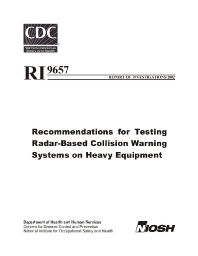 |
Researchers at the National Institute for Occupational Safety and Health are investigating technologies that could be used to detect objects, small vehicles, and pedestrian workers that may be in the blind areas of haulage equipment used in minning construction. A detection system that warns the equipment operater that there is an obstacle nearby could prevent collisions and save many lives each year. One popular technology for collision warning systems is radar. Several different types of radar have been tested in the laboratory and on minning equipment. Early in the study, questions arose concerning the best way to test radar systems. Many factors affect the performance of radar, including the size, shape, and composition of the object that is to be detected: the height of the radar antenna(s); and the relative motion of the radar system and/or object. This report discusses several different test procedures and test targets and recommends methods to determine how effective a raday system will be in detecting a person near heavy equipment.
| Author(s): | Ruff-TM |
| Reference: | U.S. Department of Health and Human Services, Public Health Service, Centers for Disease Control and Prevention, National Institute for Occupational Safety and Health, DHHS (NIOSH) Publication No. 2002-135, NIOSH Report of Investigations 9657, 2002 May; :1-17 |
ri9657 (PDF, 3118 KB)